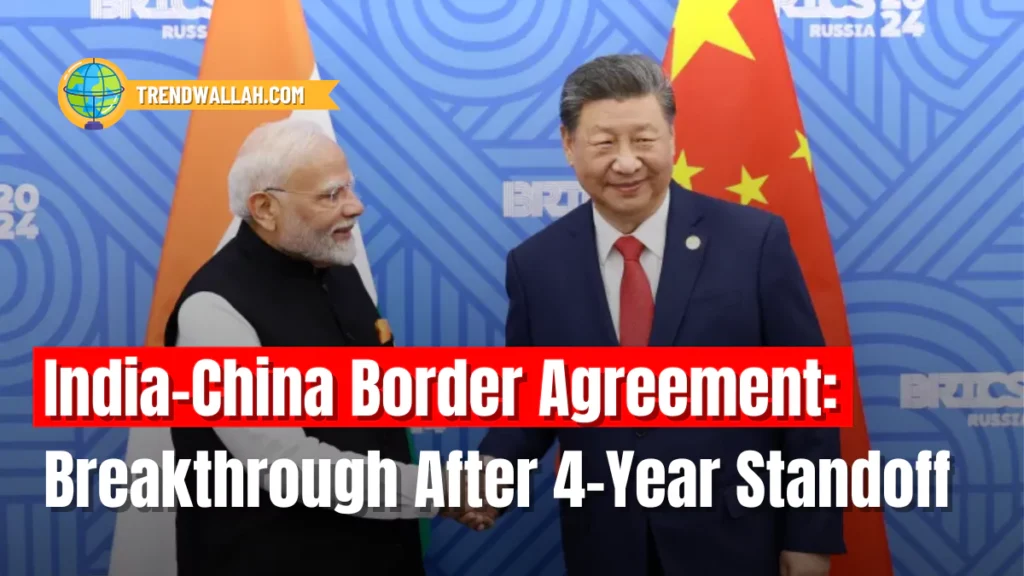
India-China Border Agreement – After years of strained relations, Indian Prime Minister Narendra Modi and Chinese President Xi Jinping held talks during the BRICS summit in Kazan, Russia. The meeting marked the first formal interaction between the two leaders in five years, signaling an attempt to restore diplomatic ties. The nations have also signed a new agreement to disengage troops along the Line of Actual Control (LAC) in eastern Ladakh, ending a four-year military standoff.
Background: Tensions Since 2020
Tensions between India and China escalated in June 2020 after a deadly clash in the Galwan Valley. This incident resulted in the loss of 20 Indian soldiers, with China also suffering casualties. Disputes over the poorly defined 3,440 km border led to increased military presence from both nations. Diplomatic talks and negotiations were ongoing, and relations remained strained until the recent agreement was reached.
Details of the India-China Border Agreement
The new agreement allows both nations to resume patrolling along the LAC, specifically focusing on the Depsang Plains and Demchok regions. Indian Foreign Secretary Vikram Misri called the deal a breakthrough in military disengagement, which has been achieved after 31 rounds of talks.
Key Points of the India-China Border Agreement
| Agreement Features | Description |
| Resumption of Patrolling | Both Indian and Chinese troops can resume patrols as before June 2020. |
| Focus Areas | Critical regions include Depsang and Demchok. |
| Patrolling Protocols | Patrols will occur twice a month with 14-15 troops per unit. |
| Coordination Mechanism | Shared patrol programs to avoid conflicts. |
Diplomatic Efforts and Meeting Highlights
The recent BRICS summit provided an opportunity for Prime Minister Modi and President Xi to meet and discuss the need for stable and amicable relations. Both leaders emphasized the importance of managing disputes and supporting each other’s development goals. The meeting followed a series of discussions, including talks between the foreign ministers in July, which aimed to resolve the border issues.
Ongoing Concerns and Remaining Issues
Despite the new agreement, several issues between India and China remain unresolved:
- Suspension of Direct Flights: Direct flights between India and China have been on hold for four years, with no plans to resume.
- Restrictions on Chinese Apps: India continues to ban several Chinese mobile apps over data security concerns.
- Skepticism Over Complete Resolution: Analysts urge caution, noting that deeper issues persist, and the agreement may not signify a complete resolution.
Expert Opinions
Experts view the agreement as a positive step, but they advise continued vigilance. While it helps in de-escalating tensions, strategic competition between the two nations is expected to persist. The broader concerns of border disputes remain, and both countries must carefully handle their differences to maintain peace.
India-China Border Agreement -Summary
- India and China signed a new border agreement after four years of military standoff.
- The deal allows resumption of patrolling in the Depsang and Demchok areas.
- Modi and Xi met at the BRICS summit, marking their first formal talks in five years.
- The agreement aims to de-escalate military presence and promote regional stability.
- Despite the deal, issues like flight suspension and app bans remain unresolved.
- Experts urge caution, stating the agreement does not signify complete resolution.
Also Read Latest Current Affairs 2024
The new agreement allows both nations to resume patrolling along the Line of Actual Control (LAC) in eastern Ladakh, aiming to ease tensions.
Tensions rose after a deadly clash in the Galwan Valley, leading to increased military presence along the disputed border.
The agreement focuses on the Depsang Plains and Demchok regions, allowing troops to patrol as they did before June 2020.
Yes, they held talks during the BRICS summit in Kazan, Russia, marking their first formal discussion in five years.
As of now, direct flights remain suspended, and no plans have been announced to resume them.
Issues like app bans, direct flight suspensions, and long-standing border disputes are still unresolved.
The agreement aims to reduce military tensions, promote stability, and support the development of peaceful bilateral relations.

